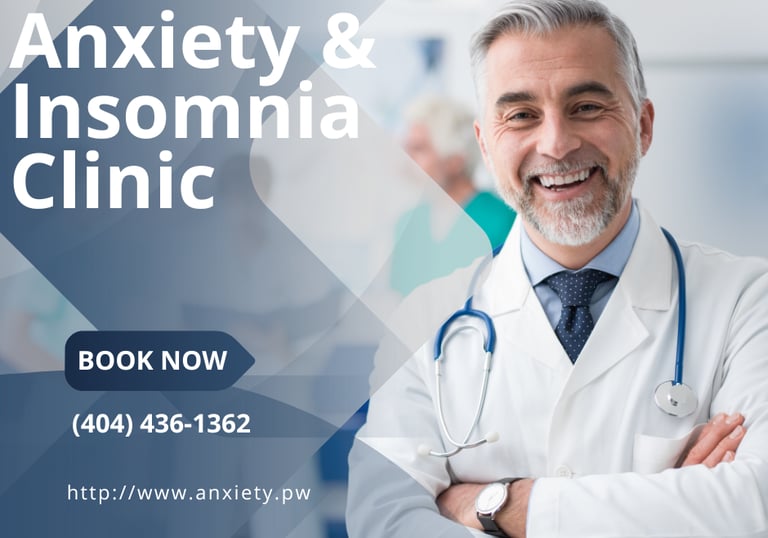For Questions: Text (833)233-0869
Anxiety, Depression & insomnia Clinic
Telemedicine Psych Clinic


In recent years, the landscape of mental health care has been transformed by the advent of telemedicine. Telemedicine, or telehealth, refers to the provision of healthcare services remotely via telecommunications technology, and it has brought unprecedented accessibility and convenience to psychiatric care. This article explores the benefits, services, patient experience, and future trends of telemedicine in psychiatric clinics.
Telemedicine in psychiatry utilizes secure video conferencing and digital communication tools to connect patients with mental health professionals remotely. This approach has proven invaluable, especially in reaching individuals in rural or underserved areas where access to mental health services may be limited.
For Questions: Text
(833) 233-0869
First of all
Welcome to Anxiety and Insomnia Clinic
Discover a variety of evidence-based treatment options offered by the Anxiety and Insomnia Clinic. Our team of psychologists, medical doctors, mid-level providers, and social workers are dedicated to enhancing the quality of life for our patients and their families. Through individual therapy, family therapy, group therapy, and medication management, we deliver skilled and tailored care to help you achieve your goals and improve your well-being.
PRICING
New Patient $197
Established Patients $187
Anxiety Pricing

Not to mention
Our Approach to Treatment
At Anxiety and Insomnia clinic, we believe in providing personalized treatment options to meet the unique needs of each patient. Our team of experienced professionals collaborates to deliver skilled and tailored care that may include individual therapy, family therapy, group therapy, and medication management. We are dedicated to enhancing the quality of life for our patients and their families.
For Questions: Text
(833) 233-0869
And let's not forget
Our Team of Experts
At Anxiety and Insomnia clinic, our team consists of psychologists, medical doctors, mid-level providers, and social workers who are dedicated to improving the lives of our patients and their families. With a focus on evidence-based treatments, our experts work together to provide comprehensive care and support for anxiety and insomnia disorders.
We understand the complexities of anxiety disorders and provide a safe, non-judgmental space where you can openly express your feelings and concerns.
Emphasis on Self-Empowerment: At the Anxiety Clinic, we believe that true healing comes from within. Our therapeutic approach emphasizes empowering you with the knowledge and skills to take charge of your anxiety and embrace life with newfound confidence. We encourage open dialogue and collaborative decision-making, ensuring you play an active role in your treatment journey.
About Anxiety Clinic
Anxiety Clinic offers a range of evidence-based treatment options delivered by a team of psychologists, medical doctors, mid-level providers, and social workers. Our goal is to enhance the quality of life for our patients and their families through tailored care.
Whether you are dealing with generalized anxiety, panic attacks, social anxiety, or any other anxiety-related challenges, our clinic offers a wide range of services to meet your needs. Our individual therapy sessions focus on uncovering the root causes of anxiety and developing coping mechanisms to manage symptoms effectively. Additionally, we offer group therapy sessions, workshops, and support groups to create a nurturing community of individuals who understand what you're going through.
Join our community here
watch & Subscribe to our youtube channel Here
Embrace calmness, conquer anxiety
Trending Anxiety topics
Generalized Anxiety Disorder (GAD) and its symptoms
Panic Disorder and panic attacks
Social Anxiety Disorder (SAD)
Obsessive-Compulsive Disorder (OCD)
Post-Traumatic Stress Disorder (PTSD)
Phobias and specific phobia treatments
Cognitive Behavioral Therapy (CBT) for anxiety disorders
Medications for anxiety disorders
Mindfulness and meditation for anxiety relief
Breathing exercises and relaxation techniques
Virtual Reality Therapy for anxiety treatment
Online therapy and mental health apps
The gut-brain connection and anxiety
Impact of exercise on reducing anxiety
Nutrition and dietary considerations for managing anxiety
Neurobiology of anxiety disorders
Trauma-focused therapy approaches
Combining medication and therapy for anxiety treatment
Art and creative therapies for anxiety management
Impact of sleep on anxiety levels
Workplace stress and anxiety
Parenting a child with an anxiety disorder
Anxiety in adolescents and teens
Role of genetics in anxiety susceptibility
Trending Anxiety topics
Generalized Anxiety Disorder (GAD) and its symptoms
Generalized Anxiety Disorder (GAD) is a mental health condition characterized by excessive and uncontrollable worry or anxiety about various aspects of life, even when there is no apparent reason for concern. The worry associated with GAD is often difficult to control and can interfere significantly with daily activities and functioning. Here are some common symptoms of GAD:
1. Excessive Worry: People with GAD experience persistent and exaggerated worry about a wide range of everyday situations and events, such as health, work, family, finances, and relationships.
2. Difficulty Controlling Worry: Individuals with GAD find it challenging to control their worrying thoughts, even when they recognize that their anxiety is excessive or irrational.
3. Restlessness and Irritability: GAD often leads to restlessness and a constant state of being on edge. People with GAD may also become easily irritable or have difficulty concentrating due to their anxiety.
4. Physical Symptoms: GAD can manifest with various physical symptoms, such as muscle tension, trembling, sweating, headaches, stomachaches, and other physical discomforts.
5. Fatigue: Chronic worry and anxiety can lead to persistent fatigue and a feeling of being mentally and physically drained.
6. Sleep Disturbances: People with GAD often have trouble falling asleep, staying asleep, or experiencing restful sleep due to their racing thoughts and anxiety.
7. Overthinking and Catastrophizing: GAD may involve repeatedly thinking through worst-case scenarios and catastrophizing potential outcomes, even when the likelihood of these scenarios is low.
8. Excessive Need for Reassurance: Individuals with GAD may frequently seek reassurance from others to alleviate their worries and anxieties.
9. Muscle Tension: Persistent anxiety can lead to muscle tension, which can cause physical discomfort and even pain.
10. Avoidance: In an attempt to manage their anxiety, people with GAD might avoid situations or activities that trigger their worries, which can lead to limitations in their daily lives.
11. Difficulty Relaxing: Individuals with GAD often struggle to relax and experience a constant sense of being on edge.
12. Physical Symptoms: In severe cases, GAD can lead to physical symptoms such as dizziness, shortness of breath, heart palpitations, and chest pain.
It's important to note that everyone experiences some level of anxiety in their lives, but GAD is diagnosed when the anxiety is persistent, excessive, and significantly impacts a person's ability to function. If you or someone you know is experiencing these symptoms and they are interfering with daily life, it's recommended to seek professional help from a mental health provider. Therapies, such as cognitive-behavioral therapy (CBT), medication, and relaxation techniques, can be effective in managing GAD.
Panic Disorder and panic attacks
Panic Disorder is a type of anxiety disorder characterized by recurrent and unexpected panic attacks. Panic attacks are intense episodes of sudden and overwhelming fear or anxiety that can be accompanied by various physical and cognitive symptoms. These attacks typically reach their peak within minutes and can be very distressing for the person experiencing them.
Key features of Panic Disorder include:
1. Recurrent Panic Attacks: Panic Disorder involves experiencing recurrent panic attacks. These attacks are often unexpected and may not have an obvious trigger. They can occur in various situations, including while the person is at rest or engaging in regular activities.
2. Worry About Future Attacks: People with Panic Disorder often develop significant anxiety about the possibility of having future panic attacks. This worry can lead to a cycle of fear where the fear of having another attack can actually trigger more attacks.
3. Behavioral Changes: Due to the fear of having panic attacks, individuals with Panic Disorder may start avoiding certain situations or places where they fear an attack might occur. This can lead to the development of agoraphobia, where they avoid situations where escape might be difficult or embarrassing.
4. Physical Symptoms: Panic attacks are characterized by intense physical symptoms such as a rapid heartbeat, sweating, trembling, shortness of breath, chest pain, dizziness, nausea, and a feeling of impending doom or loss of control. These symptoms can sometimes mimic a heart attack or other serious medical conditions.
5. Cognitive Symptoms: People experiencing panic attacks may also have cognitive symptoms, such as intense fear, a sense of unreality, detachment from oneself, and a feeling of being out of control.
The exact cause of Panic Disorder is not fully understood, but it's thought to result from a combination of genetic, biological, psychological, and environmental factors. Traumatic experiences, chronic stress, and certain medical conditions can contribute to the development of Panic Disorder.
Treatment for Panic Disorder typically involves a combination of therapies:
1. Cognitive Behavioral Therapy (CBT): CBT is a widely used therapeutic approach for Panic Disorder. It helps individuals identify and challenge negative thought patterns and beliefs that contribute to anxiety. Exposure therapy, a component of CBT, can help individuals gradually confront and desensitize themselves to the situations they fear.
2. Medication: Antidepressants and anti-anxiety medications, such as selective serotonin reuptake inhibitors (SSRIs) and benzodiazepines, may be prescribed to help manage the symptoms of Panic Disorder. These medications can be effective but should be used under the supervision of a medical professional.
3. Relaxation Techniques: Techniques like deep breathing, mindfulness, and progressive muscle relaxation can help individuals manage the physical symptoms of panic attacks and reduce overall anxiety.
4. Lifestyle Changes: Regular exercise, a balanced diet, adequate sleep, and stress management techniques can contribute to overall well-being and help manage Panic Disorder.
If you or someone you know is struggling with Panic Disorder or panic attacks, it's important to seek help from a mental health professional. A proper diagnosis and tailored treatment plan can make a significant difference in managing and overcoming this condition.
Social Anxiety Disorder (SAD)
Social Anxiety Disorder (SAD), also known as social phobia, is a mental health condition characterized by intense fear and anxiety in social situations. People with SAD often experience overwhelming self-consciousness and worry about being judged or embarrassed by others. This can lead to avoidance of social interactions or situations, which can significantly impact their daily life, relationships, and overall well-being.
Key features of Social Anxiety Disorder include:
1. Fear of Judgment: Individuals with SAD are often excessively concerned about being criticized, humiliated, or embarrassed in social situations. This fear can be out of proportion to the actual threat posed by the situation.
2. Avoidance: People with SAD tend to avoid situations that trigger their anxiety. This can include anything from public speaking, meeting new people, attending social gatherings, or even using public restrooms.
3. Physical Symptoms: Social anxiety can manifest in physical symptoms such as blushing, sweating, trembling, rapid heart rate, nausea, and difficulty speaking.
4. Negative Self-Evaluation: Those with SAD frequently engage in negative self-talk and have a tendency to interpret their own actions and behaviors in a highly critical manner.
5. Interference with Daily Life: Social Anxiety Disorder can significantly interfere with a person's ability to perform everyday tasks, pursue education or career goals, and establish and maintain relationships.
6. Co-Occurring Conditions: SAD often occurs alongside other mental health conditions, such as depression, other anxiety disorders, or substance abuse.
Treatment options for Social Anxiety Disorder include:
1. Therapy: Cognitive Behavioral Therapy (CBT) is a common and effective approach to treating SAD. Exposure therapy, a form of CBT, involves gradually exposing individuals to anxiety-inducing situations in a controlled manner to help them become more comfortable and desensitized.
2. Medications: Antidepressant medications, particularly selective serotonin reuptake inhibitors (SSRIs) and serotonin-norepinephrine reuptake inhibitors (SNRIs), can help alleviate the symptoms of SAD.
3. Support Groups: Participating in support groups or group therapy sessions can provide individuals with SAD the opportunity to share their experiences, learn coping strategies, and realize they are not alone.
4. Lifestyle Changes: Engaging in regular physical activity, practicing relaxation techniques (such as deep breathing or mindfulness), and managing stress can contribute to managing social anxiety.
It's important to note that seeking help from a mental health professional is crucial for an accurate diagnosis and effective treatment plan. If you or someone you know is struggling with social anxiety or any other mental health condition, don't hesitate to reach out for support.
Phobias and specific phobia treatments
Phobias are intense and irrational fears of specific objects, situations, or activities. They can cause significant distress and interfere with a person's daily life. There are various types of phobias, including specific phobias, social phobia (also known as social anxiety disorder), and agoraphobia.
Treatment for phobias, including specific phobias, typically involves psychotherapy and, in some cases, medication. Here are some common approaches to treating phobias:
1. Cognitive Behavioral Therapy (CBT): CBT is a widely used approach for treating phobias. Exposure therapy, a type of CBT, involves gradually exposing the person to the feared object or situation in a controlled and safe manner. Over time, this exposure helps the person become desensitized to the fear and anxiety associated with the phobia. CBT also includes cognitive restructuring, which helps individuals identify and challenge their irrational thoughts and beliefs about the phobia.
2. Systematic Desensitization: This is a type of exposure therapy that involves creating a hierarchy of feared situations related to the phobia. The person is gradually exposed to these situations starting with the least anxiety-provoking and progressing to the most anxiety-provoking. This gradual exposure helps reduce anxiety and fear reactions.
3. Virtual Reality Exposure Therapy: Virtual reality technology can be used to create realistic simulations of phobic situations. This allows individuals to experience exposure in a controlled environment, making it especially useful for situations that are difficult to replicate in real life.
4. Medications: While medication is not always the first-line treatment for phobias, it can be considered in some cases, especially when the phobia is severe or significantly impacting the person's life. Antidepressants or anti-anxiety medications may be prescribed to help manage the symptoms of anxiety and fear.
5. Mindfulness and Relaxation Techniques: Learning relaxation techniques, such as deep breathing, progressive muscle relaxation, and mindfulness meditation, can help individuals manage anxiety and stress associated with their phobias.
6. Support Groups: Being part of a support group with others who have similar phobias can provide a sense of community and understanding. Sharing experiences and strategies for coping can be beneficial.
7. Self-Help Resources: There are many self-help books, online resources, and apps that provide information and tools for managing phobias. These can be a useful complement to therapy.
It's important to note that the choice of treatment depends on the severity of the phobia, the individual's preferences, and the recommendations of mental health professionals. Effective treatment often involves a combination of approaches, and the goal is to gradually reduce the intensity of the phobia and improve the person's quality of life. If you or someone you know is struggling with a phobia, it's recommended to seek help from a qualified mental health professional.
Post-Traumatic Stress Disorder (PTSD)
Post-Traumatic Stress Disorder (PTSD) is a mental health condition that can develop in individuals who have experienced or witnessed a traumatic event. Traumatic events can include but are not limited to, serious accidents, natural disasters, acts of violence, combat exposure, sexual assault, or any life-threatening event that causes intense fear, helplessness, or horror.
PTSD can manifest in a variety of ways and can significantly impact a person's daily life, relationships, and overall well-being. Some common symptoms of PTSD include:
1. Re-experiencing Symptoms: This can involve flashbacks, nightmares, or intrusive thoughts related to the traumatic event. The person might feel as if they are reliving the traumatic experience.
2. Avoidance Symptoms: Individuals with PTSD might avoid situations, people, or places that remind them of the traumatic event. They may also try to avoid discussing the event.
3. Negative Changes in Mood and Cognition: This might include feelings of numbness, depression, guilt, or a sense of detachment from others. There can also be difficulties in remembering aspects of the traumatic event.
4. Increased Arousal: This can involve heightened irritability, difficulty concentrating, exaggerated startle responses, and trouble sleeping.
It's important to note that not everyone who experiences a traumatic event will develop PTSD. The development of PTSD is influenced by a combination of factors, including the severity of the trauma, personal resilience, pre-existing mental health conditions, and the availability of social support.
Treatment for PTSD often involves a combination of therapy and sometimes medication:
1. Psychotherapy (Talk Therapy): Cognitive-behavioral therapy (CBT) is commonly used to treat PTSD. Exposure therapy, a specific type of CBT, helps individuals confront and process their traumatic memories in a safe and controlled environment. Eye Movement Desensitization and Reprocessing (EMDR) is another therapy that has shown effectiveness for PTSD treatment.
2. Medication: Antidepressants, particularly selective serotonin reuptake inhibitors (SSRIs), are often prescribed to help manage the symptoms of PTSD. These medications can help alleviate depression, anxiety, and other associated symptoms.
3. Supportive Interventions: Building a strong support system of friends, family, and professionals can be essential in helping individuals cope with PTSD. Group therapy can also be beneficial, as it provides a safe space to connect with others who have experienced similar traumas.
4. Self-Care: Engaging in healthy lifestyle practices, such as regular exercise, maintaining a balanced diet, practicing relaxation techniques, and getting adequate sleep, can contribute to managing PTSD symptoms.
If you or someone you know is struggling with PTSD, it's important to seek help from mental health professionals who are experienced in trauma treatment. Early intervention and proper support can greatly improve the prognosis and quality of life for individuals dealing with PTSD.
Obsessive-Compulsive Disorder (OCD)
Obsessive-Compulsive Disorder (OCD) is a mental health condition characterized by persistent, unwanted, and intrusive thoughts, as well as repetitive behaviors or mental acts. People with OCD often experience intense anxiety and distress due to these obsessions, which are the intrusive and distressing thoughts or images that recur. To alleviate this anxiety, they engage in compulsions, which are repetitive behaviors or mental rituals performed in a specific, often rigid, manner.
Key features of OCD include:
1. Obsessions: These are unwanted and distressing thoughts, images, or urges that repeatedly enter a person's mind. These thoughts are difficult to control and often evoke feelings of anxiety, guilt, or disgust.
2. Compulsions: Compulsions are repetitive behaviors or mental acts that individuals with OCD feel compelled to perform in response to their obsessions. These actions are intended to reduce the anxiety caused by the obsessions, but they provide only temporary relief and often become a cycle of behavior.
3. Anxiety and Distress: People with OCD experience significant anxiety and distress related to their obsessions and the need to perform compulsions. The anxiety can become overwhelming and can interfere with daily functioning.
4. Time-Consuming: OCD rituals and behaviors can take up a significant amount of time, sometimes hours each day, causing disruption to daily life and activities.
5. Impairment: OCD can significantly impact a person's daily functioning, including their work, social life, and relationships, due to the time and mental energy devoted to managing obsessions and compulsions.
6. Insight: Some individuals with OCD recognize that their obsessions and compulsions are irrational, but they still feel compelled to engage in these behaviors to reduce anxiety.
It's important to note that OCD exists on a spectrum, meaning the severity of symptoms can vary widely from person to person. The exact cause of OCD is not fully understood, but a combination of genetic, neurological, behavioral, cognitive, and environmental factors is believed to contribute to its development. Effective treatments for OCD include:
1. Cognitive Behavioral Therapy (CBT): This is the most common and effective psychotherapy for OCD. Exposure and Response Prevention (ERP), a specific type of CBT, involves gradually exposing individuals to their obsessions and preventing the corresponding compulsions. Over time, this helps reduce the anxiety associated with the obsessions.
2. Medications: Selective serotonin reuptake inhibitors (SSRIs), which are a type of antidepressant, are often prescribed to manage OCD symptoms. They can help alleviate the anxiety and distress associated with the disorder.
3. Combination Therapy: In some cases, a combination of CBT and medication can be particularly effective in managing OCD symptoms.
If you or someone you know is struggling with symptoms that resemble OCD, it's important to seek help from a mental health professional. Early intervention and appropriate treatment can significantly improve the quality of life for individuals living with OCD.
Cognitive Behavioral Therapy (CBT) for anxiety disorders
Cognitive Behavioral Therapy (CBT) is a widely recognized and effective approach for treating various mental health issues, including anxiety disorders. CBT is based on the idea that our thoughts, feelings, and behaviors are interconnected, and by identifying and changing negative thought patterns and behaviors, individuals can experience significant improvements in their emotional well-being.
When applying CBT to anxiety disorders, therapists typically follow a structured approach that involves several key components:
1. Psychoeducation: The therapist provides information about anxiety, its causes, and its effects on thoughts, emotions, and behaviors. Clients learn to understand the relationship between their thoughts, feelings, and anxious reactions.
2. Cognitive Restructuring: This involves identifying and challenging negative thought patterns and replacing them with more rational and realistic thoughts. Clients learn to recognize distorted thinking (such as catastrophizing or overgeneralization) and replace it with balanced, evidence-based thoughts.
3. Exposure Therapy: Exposure therapy is a crucial component of CBT for anxiety disorders, especially phobias and obsessive-compulsive disorder (OCD). Clients are gradually exposed to feared situations, objects, or thoughts in a controlled and systematic manner. Over time, this exposure helps to desensitize the anxiety response.
4. Behavioral Experiments: Clients engage in behavioral experiments to test the validity of their anxious thoughts and beliefs. By gathering evidence through these experiments, clients can challenge their distorted thinking and gain a more accurate perspective on their fears.
5. Relaxation Techniques: Teaching clients relaxation techniques like deep breathing, progressive muscle relaxation, and mindfulness can help them manage their physiological responses to anxiety.
6. Homework Assignments: Therapists often assign homework between sessions to help clients practice the skills they're learning in real-life situations. This can reinforce the therapeutic process and promote lasting change.
7. Goal Setting: Collaboratively setting realistic and achievable goals is an important aspect of CBT. Clients work with their therapists to identify specific areas of improvement and track their progress over time.
8. Mindfulness and Acceptance: In some cases, mindfulness-based techniques may be integrated into CBT. Mindfulness helps clients become more aware of their thoughts and feelings without judgment, which can reduce their reactivity to anxiety-provoking situations.
9. Stress Management: Learning effective stress management skills can help individuals cope with everyday stressors and prevent the escalation of anxiety.
10. Maintenance and Relapse Prevention: Once clients have made progress, therapists focus on strategies to prevent relapse and maintain the gains achieved during therapy. This may involve developing a relapse prevention plan and providing ongoing support.
It's important to note that CBT is not a one-size-fits-all approach, and therapy should be tailored to each individual's needs and specific anxiety disorder. CBT can be delivered in individual or group settings, and it's often used as a standalone treatment or in combination with medication, depending on the severity of the anxiety disorder.
If you or someone you know is struggling with anxiety, it's advisable to seek help from a qualified mental health professional who is experienced in delivering CBT or other evidence-based treatments.
Medications for anxiety disorders
The choice of medication depends on various factors, including the specific type of anxiety disorder, the severity of symptoms, and individual medical history.
Here are some classes of medications commonly prescribed for anxiety disorders:
Selective Serotonin Reuptake Inhibitors (SSRIs):
Fluoxetine (Prozac)
Sertraline (Zoloft)
Paroxetine (Paxil)
Escitalopram (Lexapro)
Fluvoxamine (Luvox)
Serotonin-Norepinephrine Reuptake Inhibitors (SNRIs):
Venlafaxine (Effexor)
Duloxetine (Cymbalta)
Desvenlafaxine (Pristiq)
Benzodiazepines:
Alprazolam (Xanax)
Clonazepam (Klonopin)
Lorazepam (Ativan)
Diazepam (Valium)
Buspirone (Buspar): An anti-anxiety medication that works differently from benzodiazepines and does not carry the same risk of dependence.
Beta Blockers: These are sometimes used to manage physical symptoms of anxiety, such as heart palpitations and trembling. Propranolol is a common example.
Tricyclic Antidepressants: Although less commonly prescribed due to newer options, these can still be used for certain anxiety disorders. Examples include imipramine and clomipramine.
Monoamine Oxidase Inhibitors (MAOIs): These are usually reserved for cases that don't respond to other treatments due to dietary and medication interactions. Examples include phenelzine and tranylcypromine.
Pregabalin (Lyrica): Sometimes used to treat generalized anxiety disorder.
It's important to note that medications may take some time to work and might have side effects. Additionally, the choice of medication should be made by a qualified healthcare professional who considers your individual medical history and needs.
Therapies such as cognitive-behavioral therapy (CBT), exposure therapy, and mindfulness techniques are often used in combination with medications for treating anxiety disorders. In many cases, a combination of medication and therapy yields the best results.










